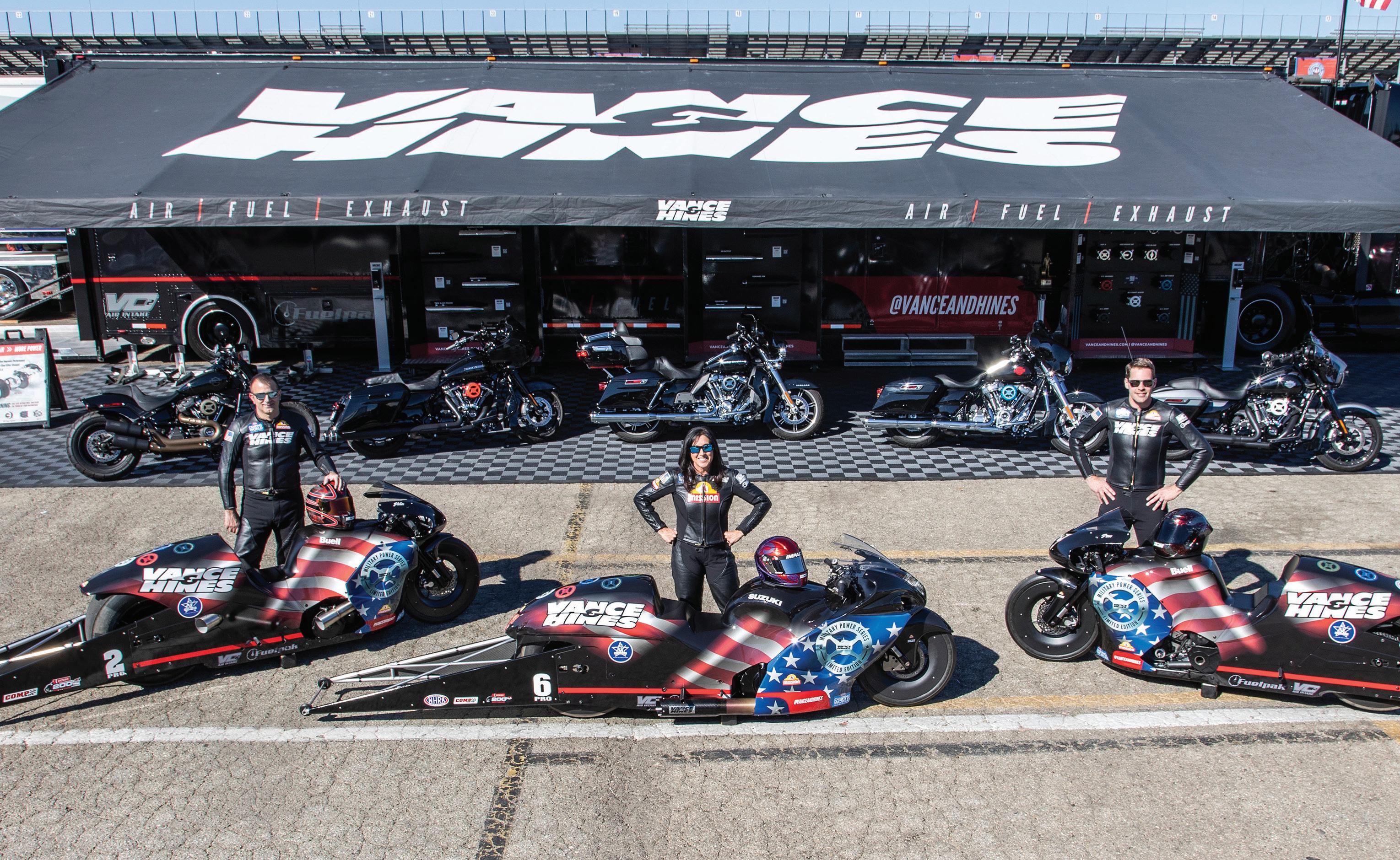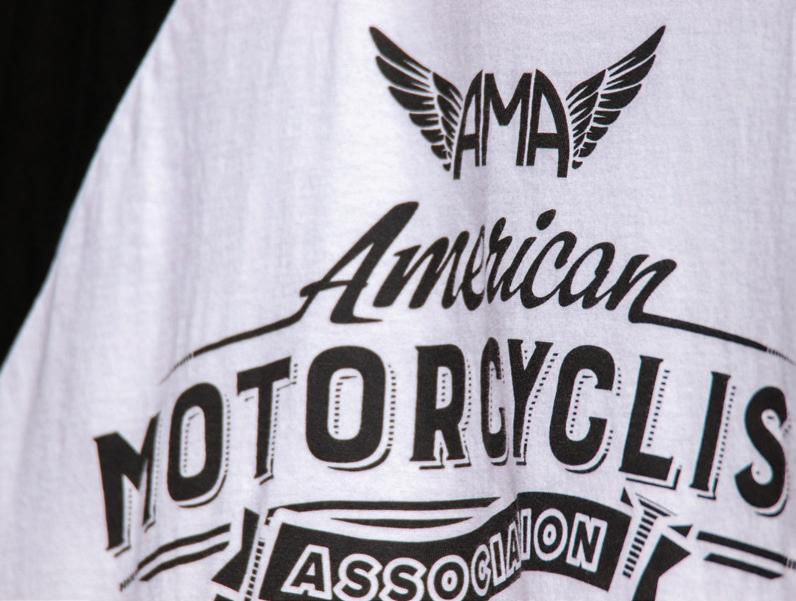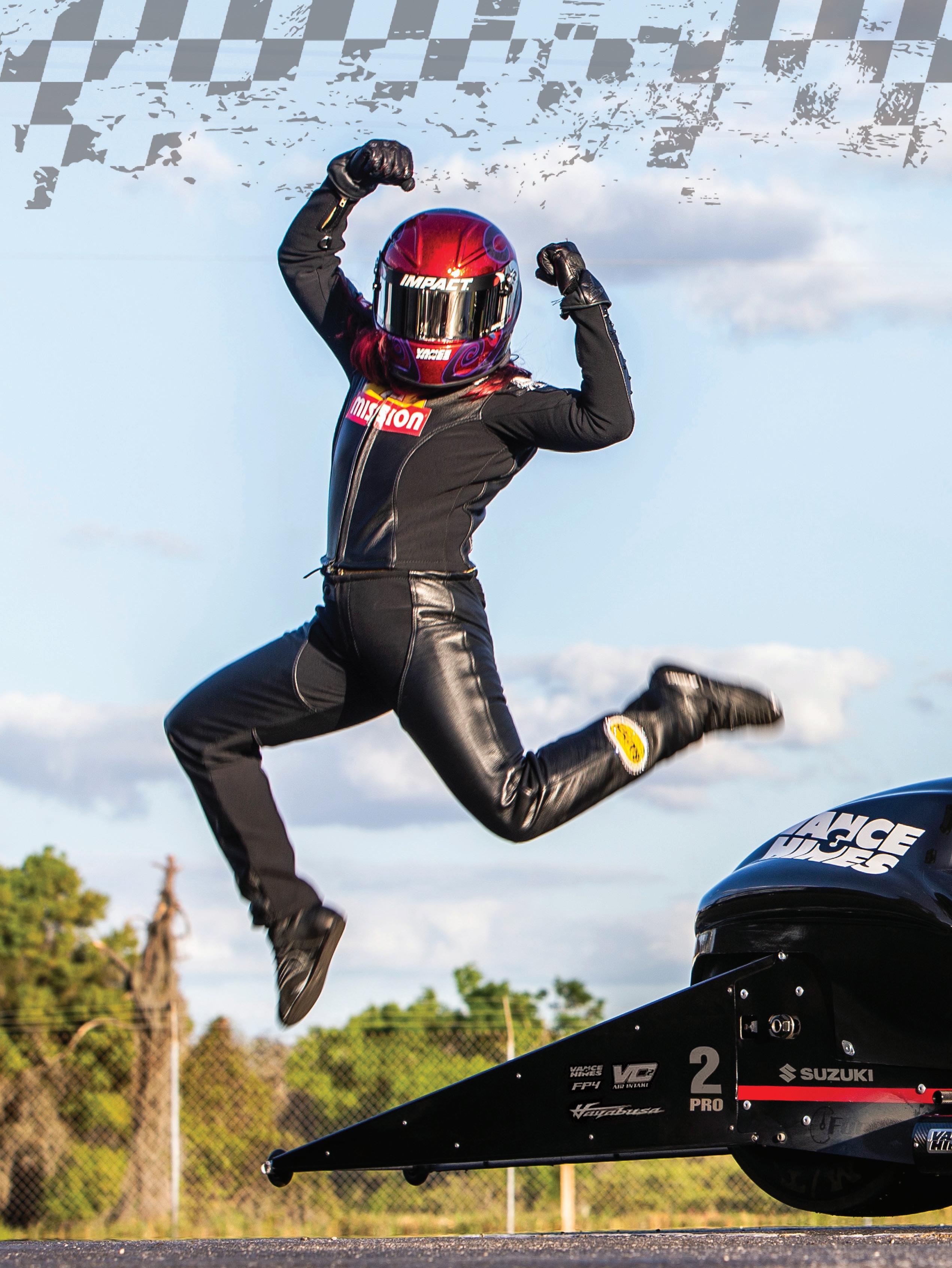
19 minute read
COVER STORY THE DRAGON LADY
From motocross roots to the leading lady of drag racing, Vance & Hines Suzuki’s Angelle Sampey reigns as the winningest woman in motorsports DRAGON LADY
BY JOY BURGESS PHOTOS: MATT POLITO & SAMPEY ARCHIVES
I
’ve never really felt very significant in my life,” Vance & Hines Suzuki NHRA Pro Stock Motorcycle racer Angelle Sampey told me, her voice quiet with emotion. “I’m just a little, insignificant girl.”
“But when I put on a helmet and get on my bike,” she added, “I become a fire-breathing dragon!”
Angelle’s racing career backs up that Dragon Lady MO. She’s the winningest female in NHRA racing — and all of motorsports (let that sink in a minute…), with 45 pro wins to her credit (at presstime), three NHRA Pro Stock Motorcycle championships, and in 2021 reset Suzuki’s alltime best speed of 202.03 mph, a career-best.
The biggest name in all of motorcycle drag racing backs Angelle up, too.
“Angelle made it clear that women can win in this sport,” AMA Motorcycle Hall of Famer and 14-time NHRA champion Terry Vance told American
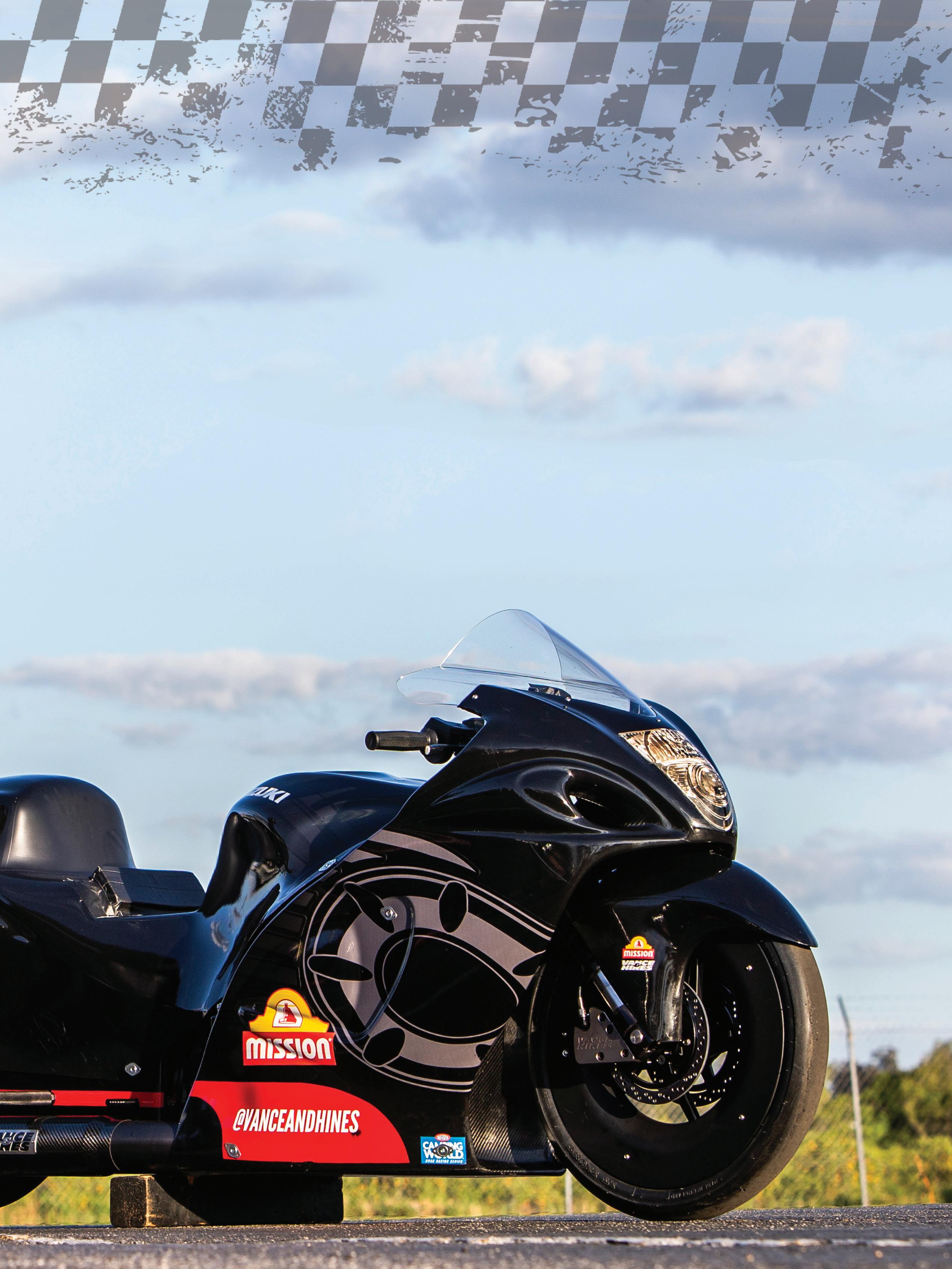
Motorcyclist. “I’m a 14-time champion, I’m in every Hall of Fame, and I understand this sport. I even helped the NHRA develop the class as a pro sport. And I still believe that Angelle’s without question the most significant person to ever ride a Pro Stock motorcycle.”
Coming from Terry Vance, the co-founder of Vance & Hines and arguably the most legendary name in Pro Stock drag racing history, that’s saying a lot.
Shirley Muldowney — an American auto racer and the first woman to
receive a license from the National Hot Rod Association (NHRA) — blazed a trail for women in drag racing, won three NHRA Top Fuel championships and once held the record as the winningest NHRA female racer with 18 victories. But in 2001, Angelle broke that record and throughout her career has continued making history for women.
As the leading lady in a sport where lightning-fast reaction time and proper hook-up and shifting off the line are
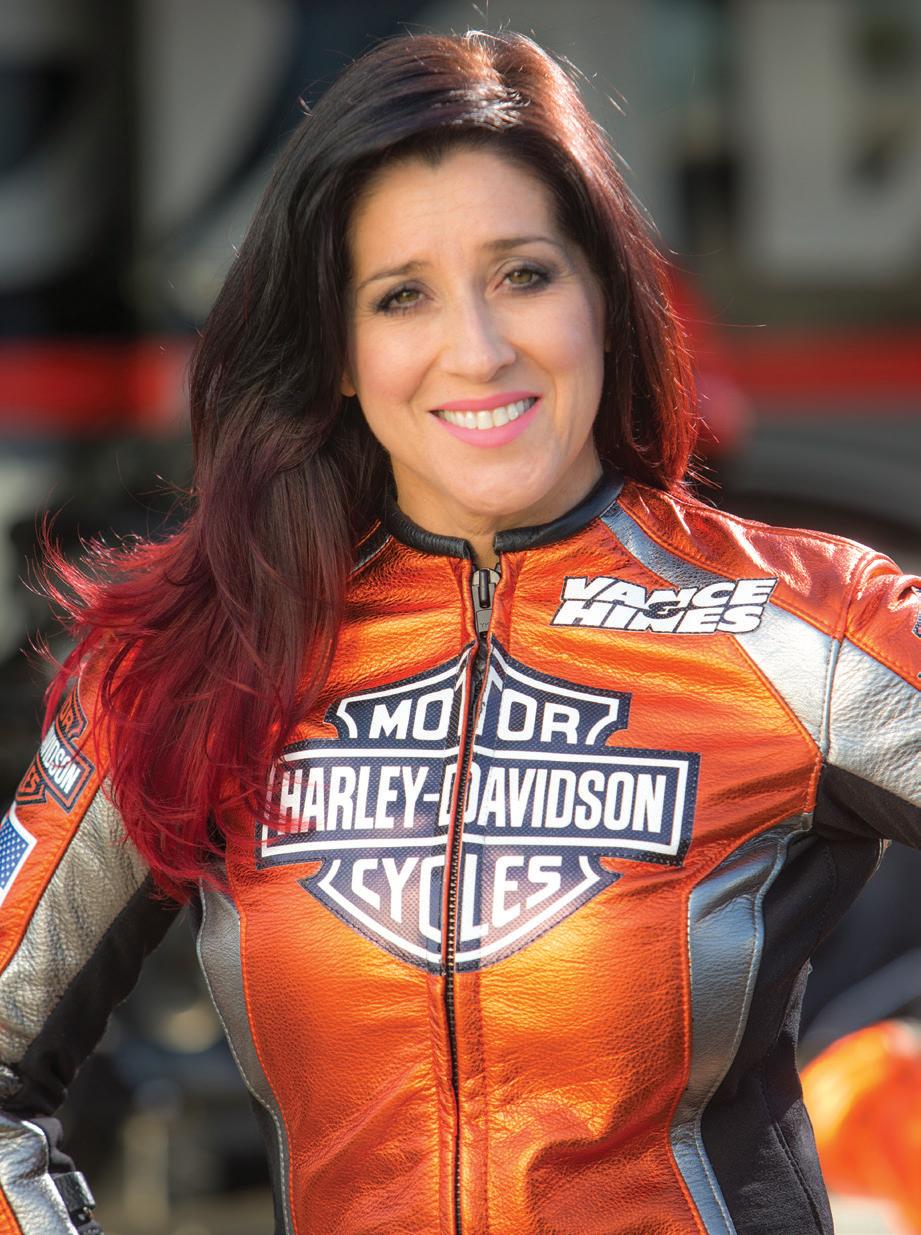

As a kid, Angelle’s mother made her black and orange leathers, and years later she found herself wearing Vance & Hines/Harley-Davidson leathers in the same hues. She won aboard the H-D Street Rod Pro Stocker (right) — which she calls “the most challenging motorcycle I ever raced” — in 2020 at Indy.
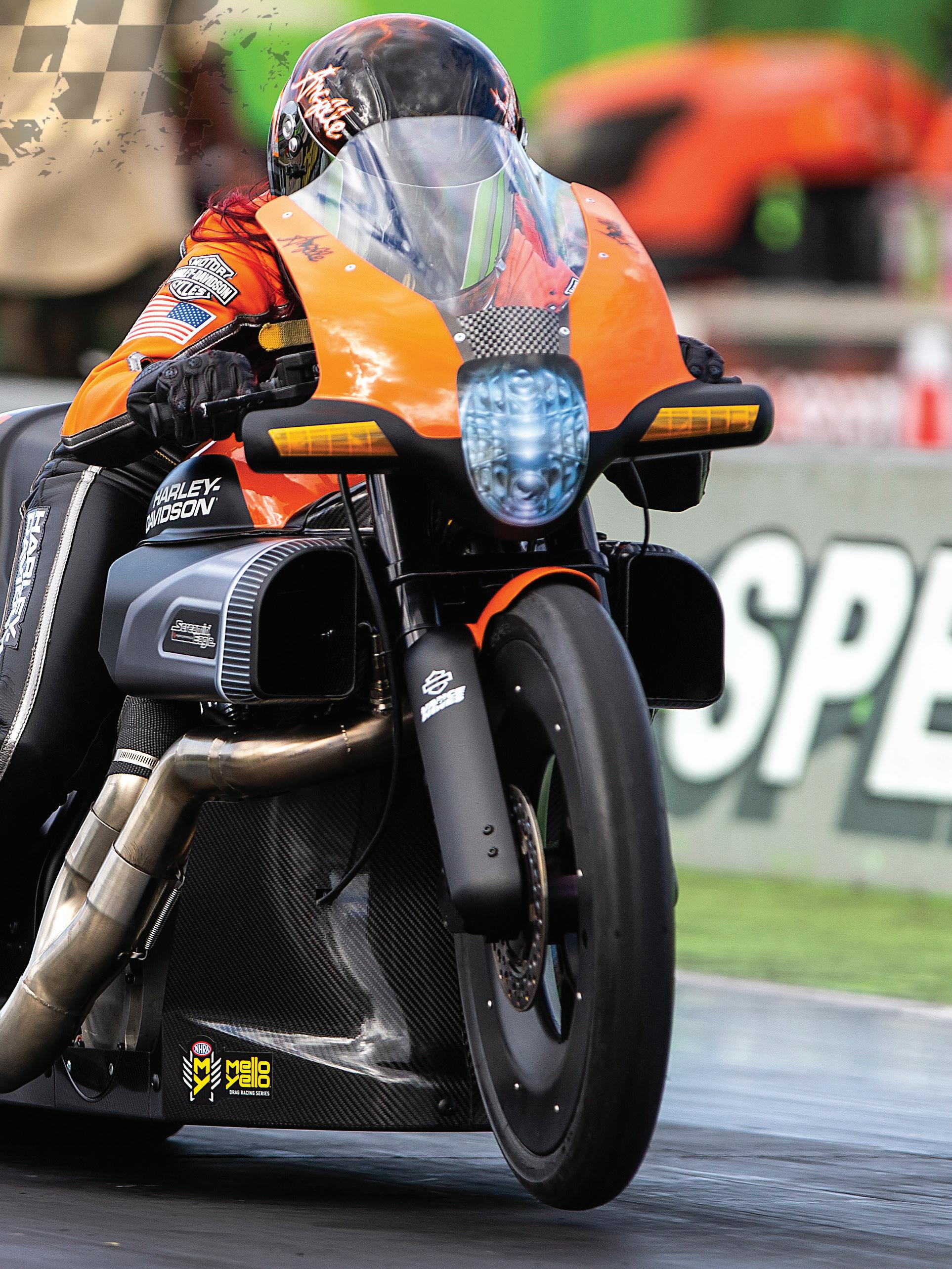
critical to winning, it’s not surprising that Angelle’s motorcycle roots trace back to racing motocross.
“I was always around boys — my brother, cousins, dad, uncle — who raced motocross,” Angelle remembers. “Around age 6 I started begging for my own dirt bike, but my dad didn’t want me to have anything to do with motorcycles. He wanted me to be a ballerina! I whined enough about it and put up a fight, and finally ended up getting one.”
“I still remember waking up on my sixth Christmas,” she continued, “and there was a Suzuki RM50 under the tree. I couldn’t believe it! I didn’t think my dad would actually do it!”
ANGELLE SAMPEY


Her dad thought the RM would give her something to do while he focused on helping her brother work towards becoming a motocross champ. But that wasn’t Angelle’s plan at all.
“I wanted to race like my brother did,” she said. “My dad finally gave in and I raced in the Powder Puff class, but that wasn’t good enough. Finally, I got to race in the regular boys’ classes around 1976, as there was no girl’s class at the time. I pretty much sucked. I’d get the holeshot but get passed in the first turn. It’s funny now, but my mom even said in passing that I’d probably grow up to be a drag racer because I always got that holeshot.”
Once Dad realized racing was something she really wanted to do, she got to compete in more classes and at more tracks, and even raced as an amateur at an AMA Supercross in the New Orleans Superdome one year. The family’s motocross racing days eventually came to an end, but Angelle kept riding dirt bikes.
“I’d outgrown my 50 and was riding my brother’s 80, and one day my dad came home and saw me hanging out with all the boys talking about dirt bikes. He ran all the boys off and said this had to stop. He’d had enough of me and the dirt bikes and told my mom she needed to teach me how to be a girl, so I was forced into competing in beauty pageants at about 13 years of age.”
What her parents didn’t know was that, even after he sold her bike, she was still riding as often as she could.
“I was obsessed with motorcycles,” Angelle told us, “it was all I wanted to do. When they got rid of our bikes, I was riding friends’ bikes. I had a friend who had a street bike, and he’d pick me up and we’d go riding. At around age 17 I’d sneak out in the middle of the night to go ride with him, and that was when my passion for bigger bikes really started. I


Angelle aboard her Suzuki GS1100 Super Comp bike in the 1990s. She sold it to attend Frank Hawley’s Drag Racing School — she was all in! Far left: Growing up for Angelle was a mix of ballerina days and beauty pageants interspersed with her real love — the Suzuki RM50 her dad bought her one Christmas.
wanted a street bike so bad.”
A couple years later, Angelle married. And when her husband went off to fight in the Gulf War, he left his bike with her and asked her to take care of it while he was gone. It was a request she gladly accepted.
“I basically gutted the bike… lowered it, took off the headlights, taillights, license plate and mirrors, and started taking it out to the State Capitol Raceway to drag race it. A friend invited me to the Cajun Nationals — the NHRA drag race that takes place at State Capitol Dragway — and that’s where I was first introduced to NHRA drag racing.”
“I fell in love at that moment!” Angelle says, “and I knew I wanted to do it. I wasn’t as good on a dirt track, but I was really good on a start line, popping the clutch and racing to the first turn.”
Eventually, she purchased her own drag bike, a Suzuki GS1100, and raced it in the Super Comp class at State Capitol Dragway. But that wasn’t enough. She had her mind set on Pro motorcycle drag racing but didn’t have a clue how she’d get there.
Meanwhile, Angelle went to college, first working toward a TV production career (she had a strong interest in photography and video though she’d dreamed of being a nurse as a girl), and then switched to nursing at the Charity School of Nursing, where she became a registered nurse.
“I decided I wanted something that wouldn’t be competitive,” she said with a laugh. “Imagine that!”
“Funny story,” she continued. “I worked the night shift, and when things were slow I’d practice my autograph on the patient boards in the middle of the night. One of the male nurses asked me what I was doing. ‘I’m practicing writing my autograph,’ I said, ‘because one day
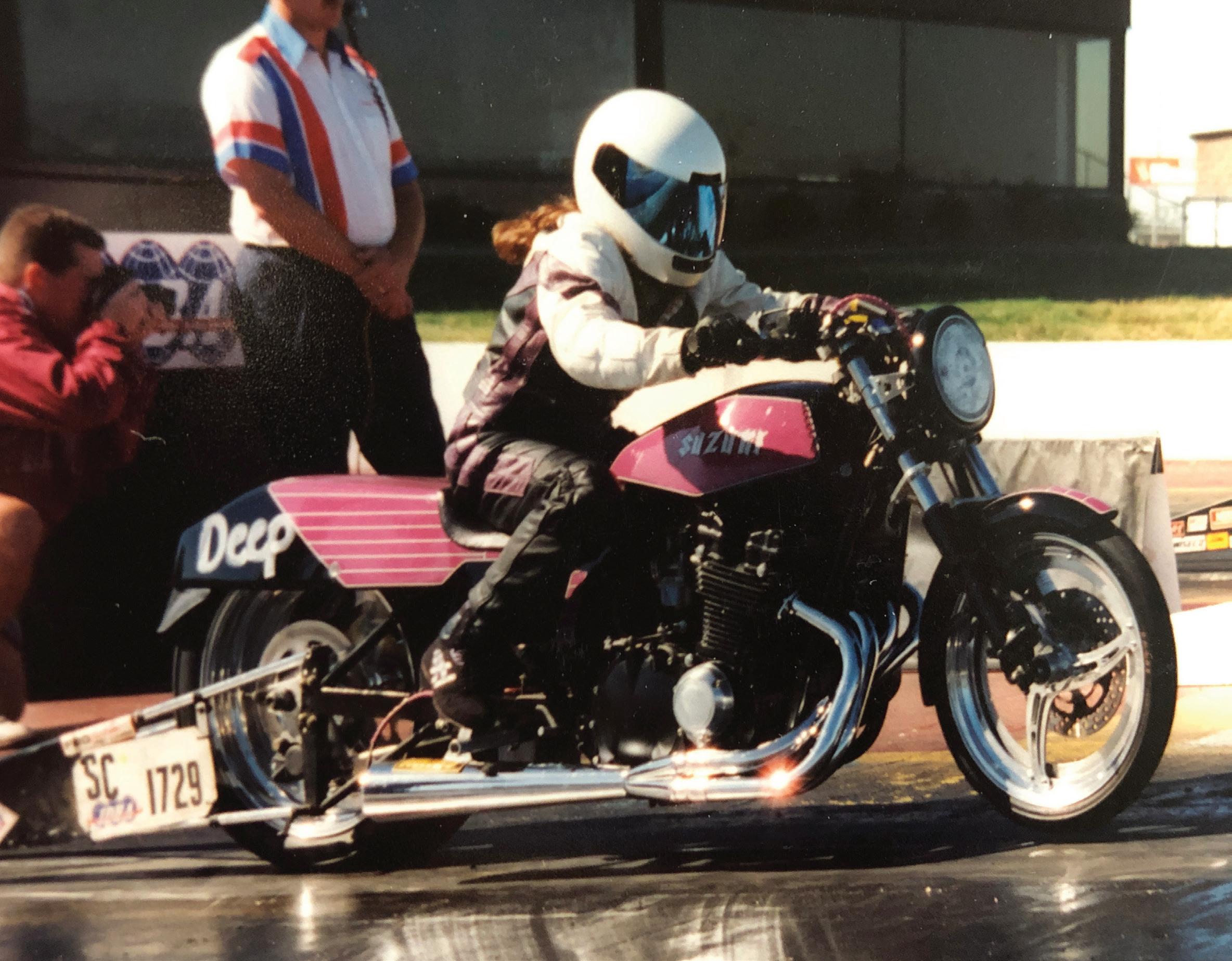
I’m gonna be a pro racer and sign autographs.’ Everyone laughed.”
One reason she decided on nursing was due to the cost of racing. “Super Comp racing was very expensive,” she noted, “And I knew I had to have a good job that paid well. It wasn’t easy becoming a nurse. I’d call it the best and worst thing I’ve been through in my life. But I got a job right away and was using it to pay my way in my then-drag-racing hobby.”
Nursing was her day job; but she still longed to make drag racing her career.
“One day I found out about Frank Hawley’s Drag Racing School [run by two-time NHRA World Champion and nine-time NHRA National Champion Frank Hawley —Ed] in Gainesville, Fla. You can go be a student and get your drag-racing license. I sold my Super Comp bike to afford to go…I was all in. And that’s where I met George Bryce of Star Racing, the first team I ever competed with.”
“Bryce hired me from the school,” Angelle continued, “and we started training together. I’d gotten my first Super Comp bike when I was about 21, and by age 26 I was competing professionally in the NHRA circuit.”
But once on the Star Racing team, it wasn’t easy. She was starting at the bottom.
“Those Pro Stock bikes were so big and powerful, and I was so little,” Angelle remembers “and I really didn’t know what I was doing. I was teamed up with a great group of people, though, who had the expertise to teach me.”
“Even after I had my Pro Stock license,” she went on, “I wasn’t really ready to ride a Pro Stock bike. I was training with the team, following [three-time NHRA champion and
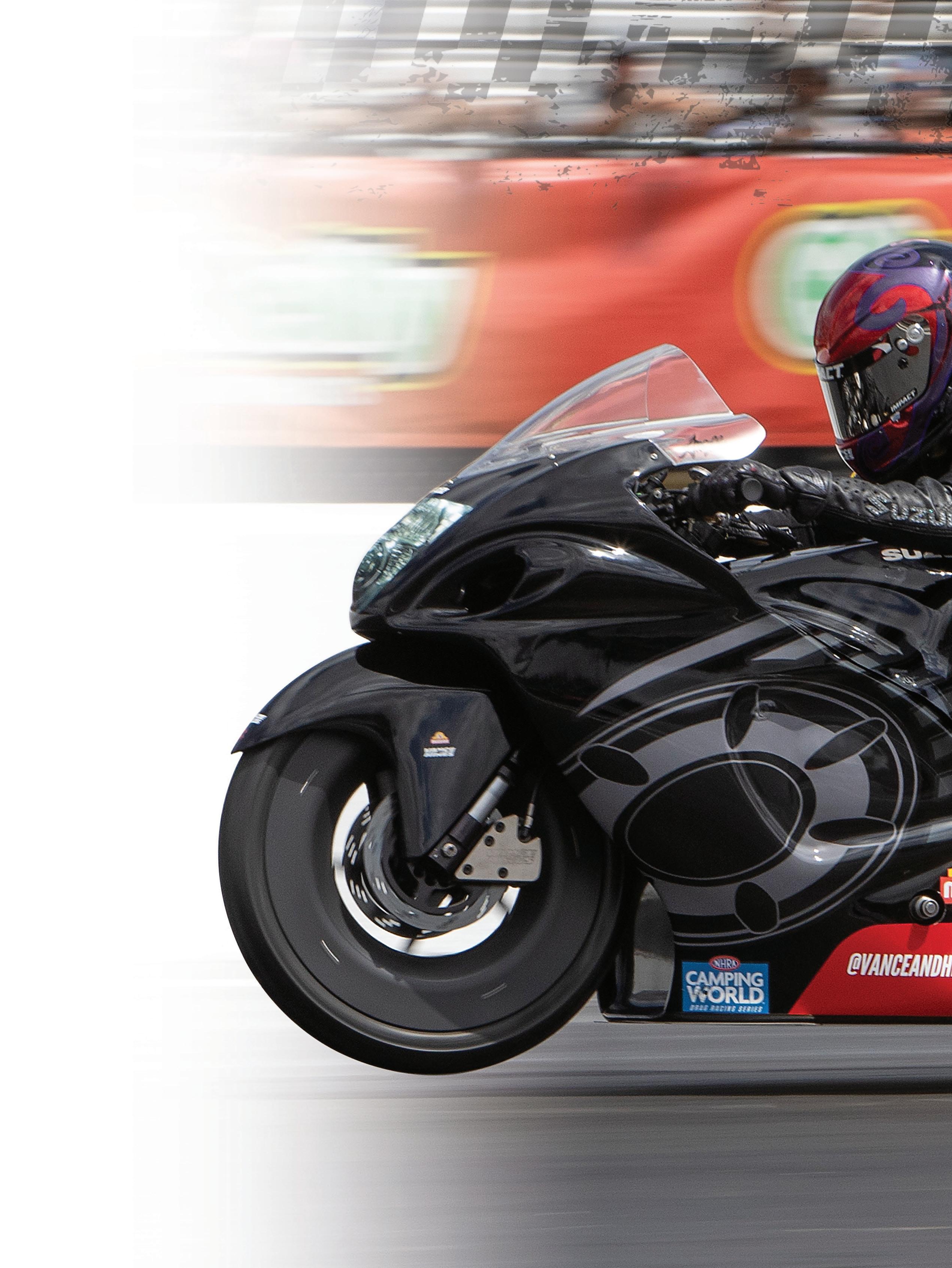

HEATHER MALENSHEK
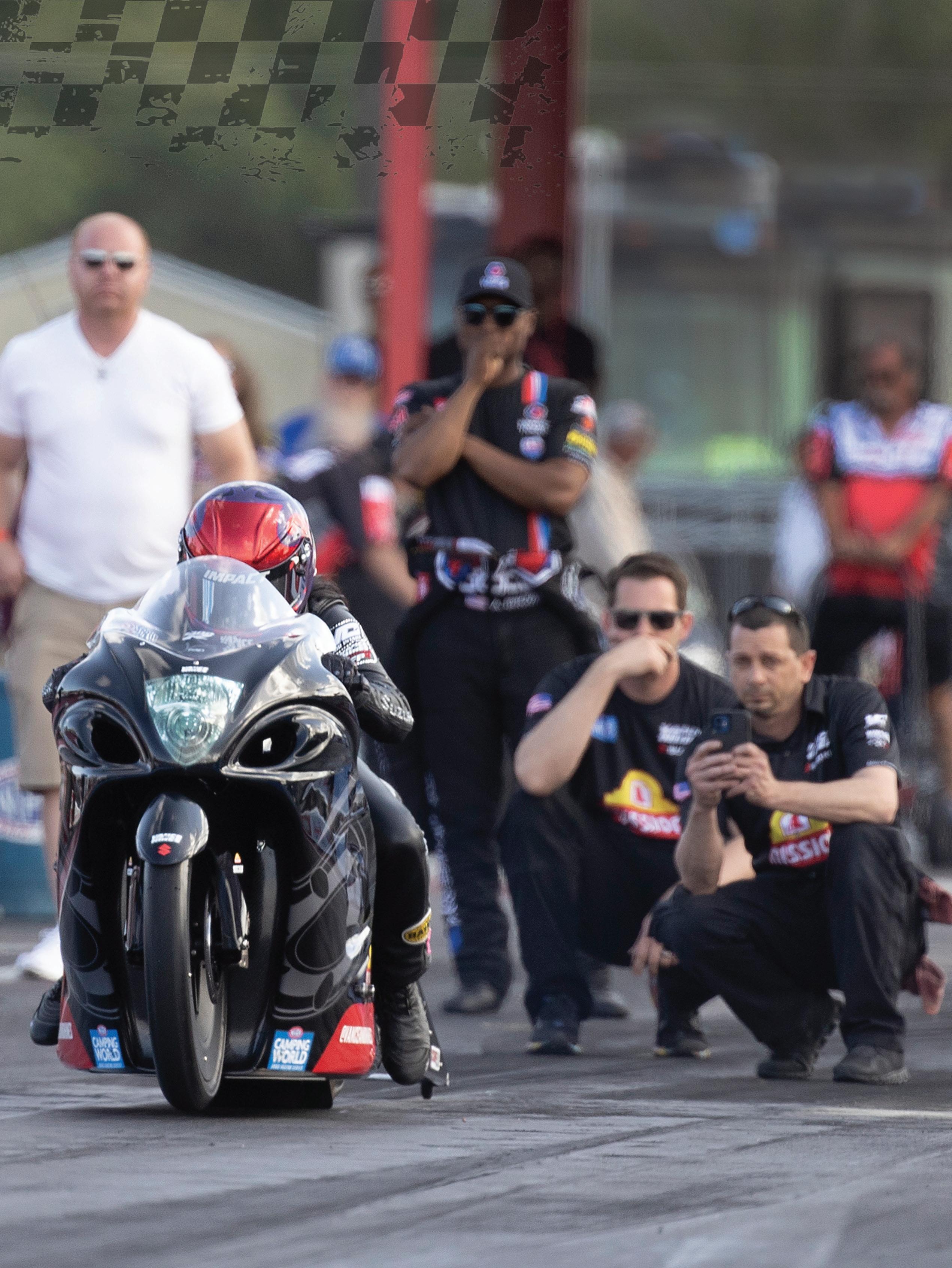
three-time AMA Prostar Pro Stock Bike champion] John Myers and just shadowing him everywhere he went. I watched him ride. Learned what to do on camera and how to handle public appearances.”
After Meyer’s competed at an NHRA event, the team would often stay another day to do a test and tune. “I’d get the chance to do some passes, or we’d visit local tracks and I’d do some passes.”
“I wasn’t that great,” she said with a chuckle. “I could burnout and go straight down the track. But I wasn’t shifting right…there were so many things I wasn’t doing right. But they saw my potential, and we kept working.”
In July 1996, Angelle finally got her chance to race at an NHRA event in Denver.
“At my very first NHRA event I qualified fourth,” she said. “I went all the way to the Semi round and lost to then-currentchampion Dave Schultz. That was an amazing feat at my first race! And because I did so well I went out again at the next race and qualified third or fourth. Then, at my fourth race in September of ’96 in Redding, Penn., I was the top qualifier, I set the national record and I won the race! And that’s when everything really blew up.”
Suddenly, she was invited to TV talk shows, sponsors were interested, and Angelle wasn’t about to stop now.
“I’d been testing the waters,” she told us, the excitement of that first win still evident in her voice, “but after that win, holy crap…I’m actually the national record-holder! So we kept going. I raced just half a season in ’96 and still ended up seventh in points, which is unbelievable. In ’97 I raced the full season and ended fifth. By ’99 I was second in points, losing the championship by just 14 points. And then in 2000 I finally won the world championship, backed that up in 2001, and in 2002 won my third championship in a row!”
From her start in 1996 through 2008, she never went a season without winning races. But at the end of 2008 — after racing to a total of 41 pro wins — she decided that it was time to hang up her leathers.
“I left the sport,” Angelle said, “married my now-husband Seth, had my daughter Ava, and decided drag racing was my history…something I was never going back to. And I was happy as a mom and wife. I went from this deep love and passion for
motorcycles to being completely distanced from them for six years.” But then she got a phone call. “It was my original team — Star Racing — calling me. Their rider had quit mid-season, they were sidelined, and they didn’t have anyone. They asked me if I’d come back and ride until they found a permanent rider.” “Now, I’m a mom and a wife,” she continued, “and I hadn’t been on a Pro Stock bike for six years…and they’re asking me to jump back on one? I said, ‘absolutely not!’” But when they wouldn’t take no for an answer, Angelle gave in, her goal to simply pay them back for all they did for her when she was racing. But after six years off the bike, she was scared. “We met the team The V&H/Suzuki team’s in Georgia,” she Hayabusa-based engines make nearly 400 horsepower told us, “and I got thanks largely to a from-billet on that bike and I alloy cylinder head that utilizes was so scared I was the very latest in 4-valve trembling and crying technology — though it’s tech my eyes out. They that was developed in the 1980s. The 20-pound head started the bike and starts out as a 100-lb chunk of turned on the lights aluminum. on the tree. I told myself I just wasn’t going to get on the throttle until I was 100 percent ready. But when that pre-stage light came on, everything went into auto-drive, I hit the throttle and made a full pass to the finish line, running a 6.86...a really quick run at 195mph. Well, that was good enough to go to the next race and qualify in the top five — or even win — after six years of not riding the bike.” “I stopped that bike on the racetrack,” she continued, “because all of a sudden the adrenaline kicked in. The fear was back, but I was so excited, so I made a second pass and
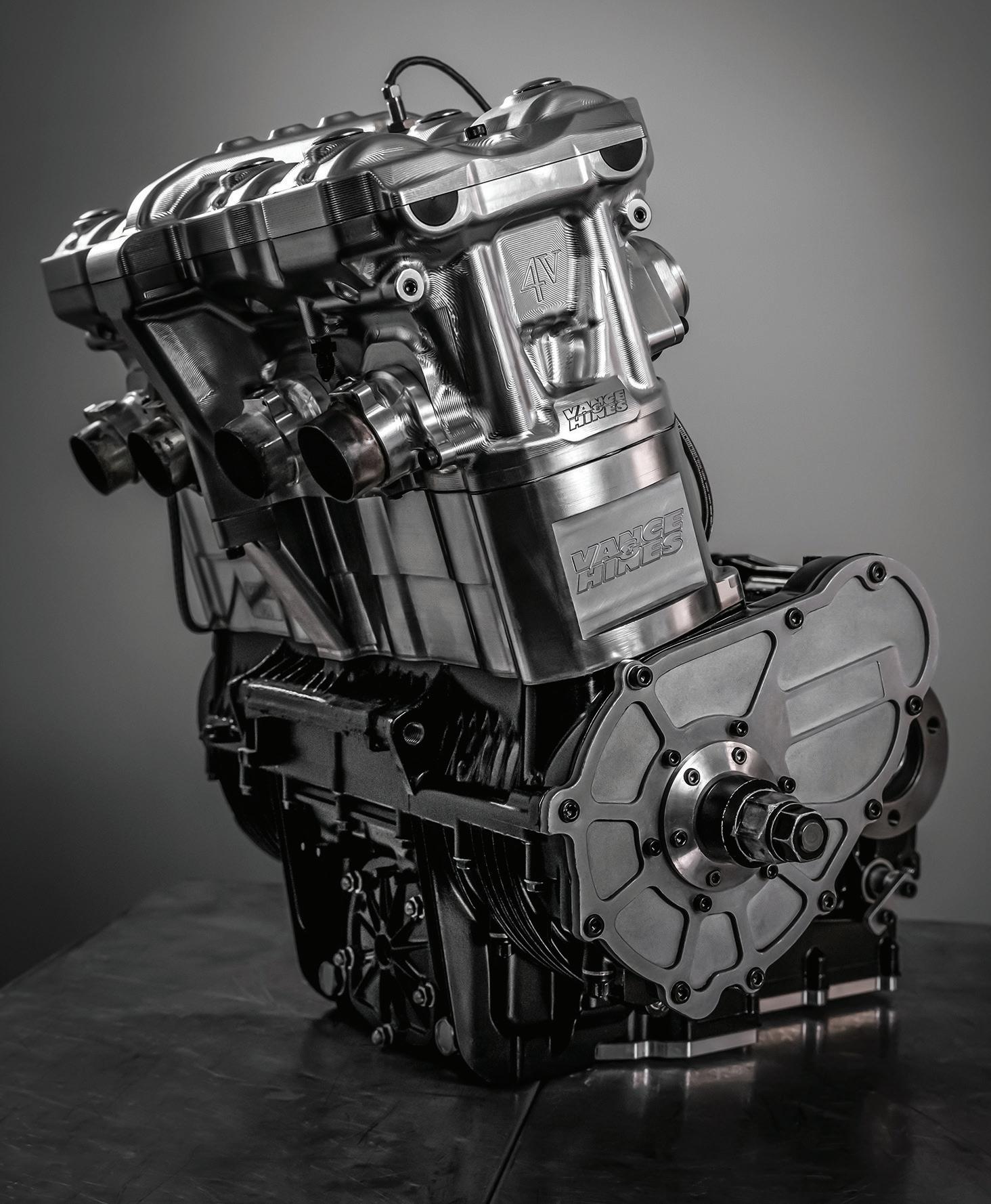
did just as well. After a third pass, I was ready! We went to the next week and told the world, ‘Guess who’s back!’”
Angelle competed the remainder of the 2014 season and raced full-time in 2015, noting that she struggled
her butt off. The sport had changed and the competition was harder. But this time around she had an entirely different reason for getting on the motorcycle.
“I saw this as an opportunity to teach my daughter what she could do if she put her mind to it,” said Angelle, adding that her daughter Ava was only three when she returned to racing.
But it wasn’t coming easy. “Ava was watching me trying to compete and failing,” Angelle remembers. “I was struggling, and wondered if I had done the wrong thing. I’d told her I’d win some races, but I hadn’t done that yet, and I started to worry I was teaching her how to fail.”
But then, finally, at Englishtown, N.J. in 2016… she won!
“I knew Ava was watching me on TV, and after my win I was so emotional when they interviewed me.
I told her I was bringing home my 42nd trophy to her. And that win…it was the most important win I’ve ever earned and the one that meant the most to me. My career started over on that day!”
The next couple of years brought more struggles, with Angelle and fellow Pro Stock racer Cory Reed starting their own team — Team Liberty. Ultimately the venture didn’t work out. Getting sponsorships was tough, the money wasn’t there, and Angelle found herself sidelined again.
“I’d come back and won a race,” she said, “and I was happy with what I’d accomplished. I was ready to quit for real and pursue the sport in another way.”
But once again, a phone call changed the direction of her life.
This time it was a phone call from Vance & Hines NHRA Pro Stock racers Andrew Hines and Eddie
Krawiec. They wanted to meet with her.
“I wanted to know why in the hell the Vance & Hines guys wanted to meet with me,” Angelle recalls. “Star Racing — my first team — was a big rival of Vance & Hines. What was this about?”
“We went to breakfast,” she continued “and they told me they were considering having a third motorcycle racer for the 2019 season and asked if I’d be interested. At first I thought they were messing with me, honestly, but once I realized they were serious, my answer was yes! I was freaking out.”

Above: Angelle holding one of the 45 “Wally” trophies she’s won, this one in 2021. The trophy pays tribute to NHRA founder Wally Parks and was first presented to winners in the 1969 season. The NHRA warns, “He is elusive. Only the very best can catch him.” Opposite: Angelle celebrating her first-ever Wally with her Star Racing team.


ANGELLE SAMPEY
While Angelle never thought she’d have the opportunity to be on the Vance & Hines team, both V&H and Harley-Davidson wanted her on board.
“[Angelle’s] probably one of the most talented riders that has ever ridden a Pro Stock bike,” Terry Vance told us, “and I went to HarleyDavidson and told then-Senior Vice President, Chief Marketing Officer
Heather Malenshek there was an opportunity to put Angelle on the team, and I thought we had to take it. Heather said to get it done, an indication of the respect level that Angelle carries with her.”
According to Malenshek, HarleyDavidson’s strategy was to build the next generation of riders. “I was particularly passionate about showcasing the strong, confident, and amazing women who are part of the sport of motorcycling,” Malenshek told us for this story. “Our drag racing program was well-established, and we had a wonderful partner in Terry [Vance] and Vance & Hines. Eddie and Andrew were tremendous ambassadors for the brand. What I felt was missing was the opportunity to showcase a female racer as another way to reach more of our audience of women.”
“What was most important,” she continued, “was that anyone we
had representing the brand share our values … I also wanted people who we could be proud to showcase as great examples of the positive side of motorcycling. Angelle was it! And I’m still in awe of her. She’s the embodiment of a strong, fearless woman who takes her place in the sport very seriously in how she helps inspire others.”
Angelle had spent 20 years of her career competing against the Vance & Hines team, and now she was wearing their team duds. It was like a dream come true, “the best thing that ever happened to me in my career,” she said. But the transition to the Harley-Davidson Street Rod drag bike was a struggle after she spent most of her career aboard inline-four Suzukis.
“The Harleys were heavy,” Angelle said, “and there wasn’t much of a fairing to block me from the wind. That was like sensory overload at
first, with 200 mph feeling more like 400 mph. The torque was fierce, and it took a lot of strength to keep up with the bike. It took some time for me to get used to it; it was the most challenging motorcycle I ever raced.”
In 2020, Angelle got her first win with the V&H team at Indy. “[After that] the pressure was off,” she said. “I’d proved I could win on the Harley. And then in 2021 we switched from the Harley-Davidsons to Suzukis. I started riding the Suzuki Hayabusa, and this year we are the factory
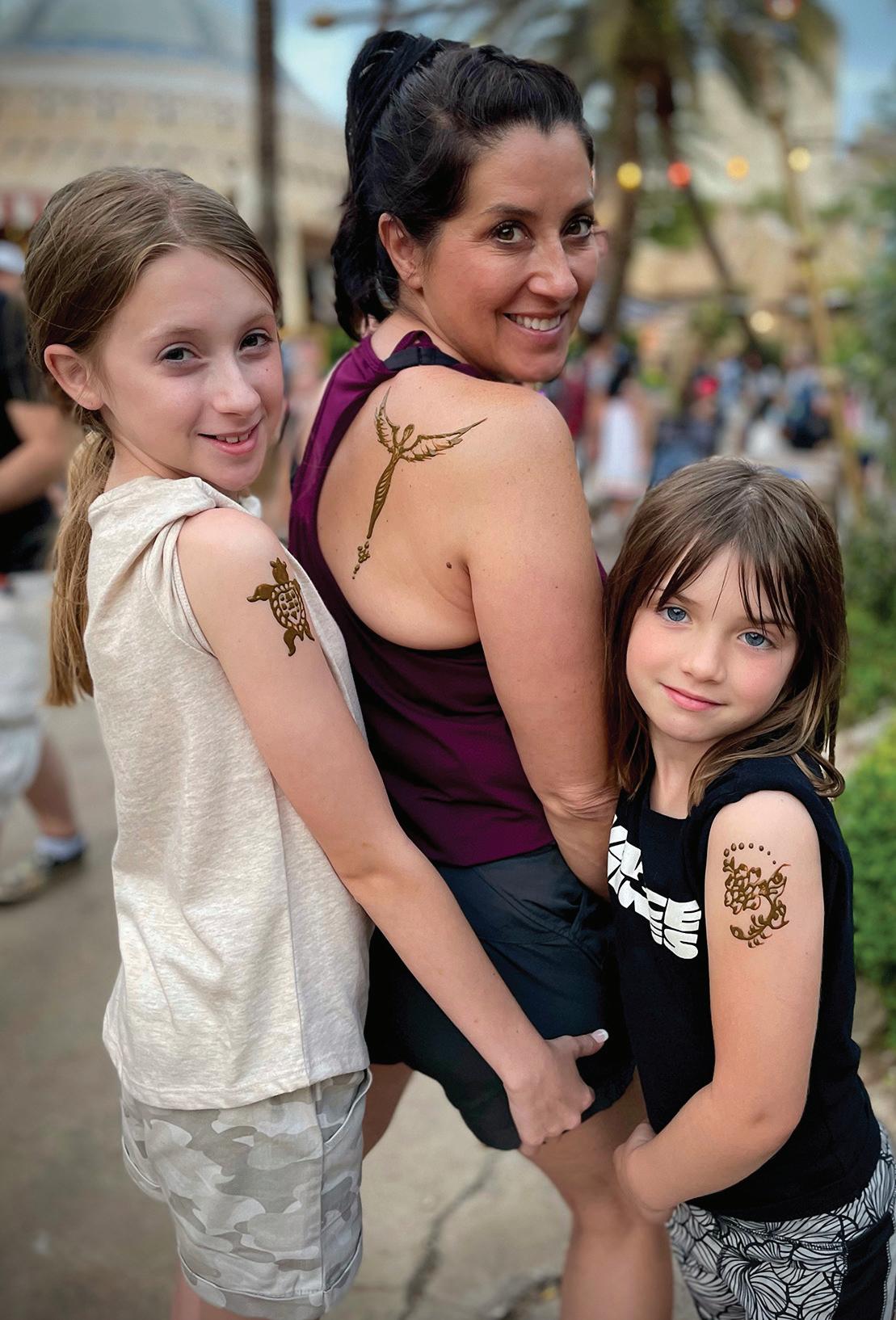
Left: Angelle with daughters Ava and Mya. Right: Ava poses aboard Angelle’s drag bike pre-race.
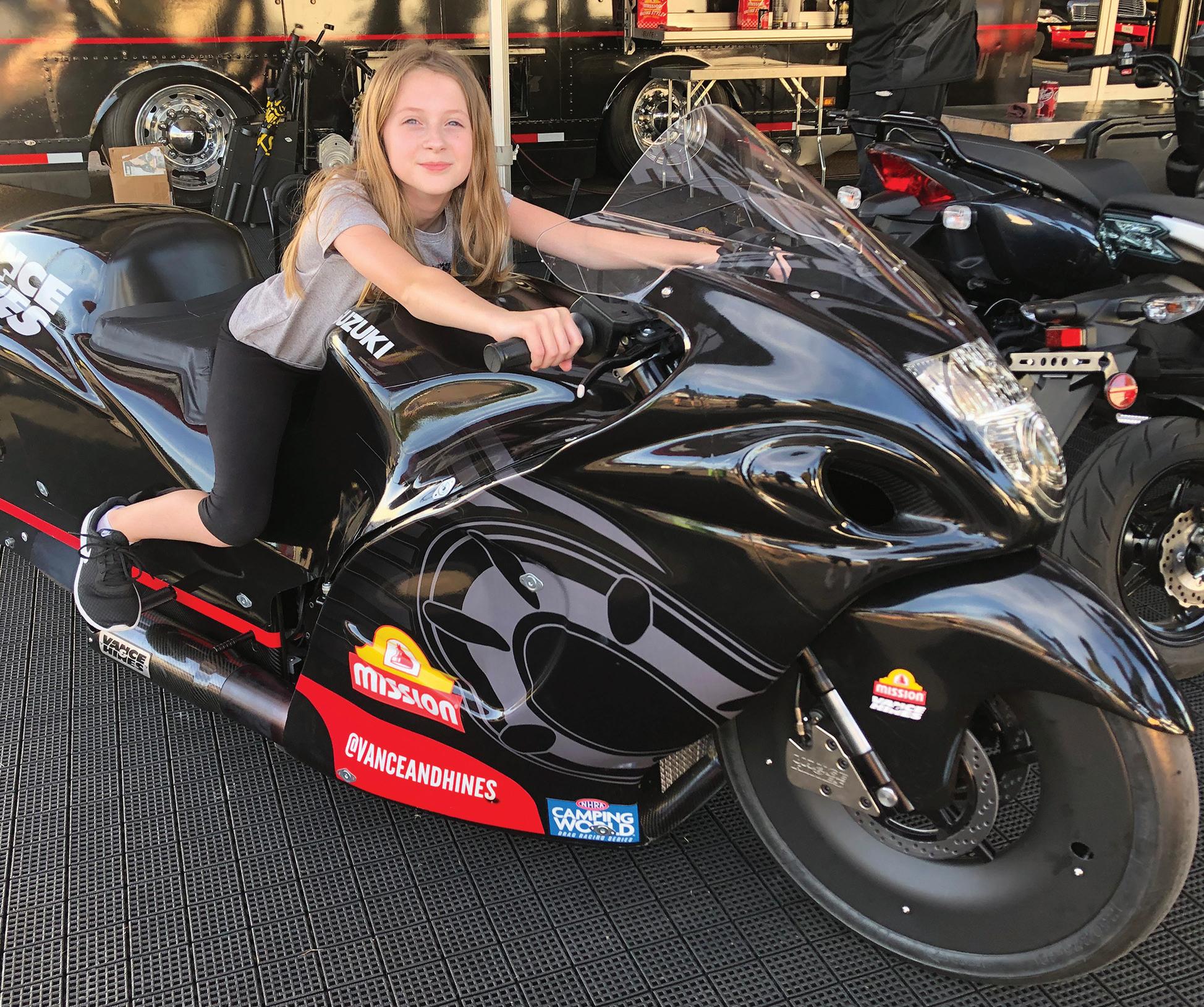
TERRY VANCE
Suzuki drag racing team.”
“I won two races last year on the Suzuki,” she continued, “and my motorcycle is really fast this year, so I expect to see the winner’s circle more than once.”
Terry Vance agrees. “I think people will be surprised about mid-season, and by the end of the year she’ll be devastating as a competitor.”
For Angelle, being part of this team is the payoff for years of feeling like she was scratching and clawing her way to success.
“It’s like all the hard work — from the day I first got on my little RM50 to now — this was what it all was for,” she said. “And I’m going to finish my career with the best team that’s ever been in drag racing.”
Looking back, the now-51-year-old says she’s still in awe of how it all happened.
“At the start I had no help, no
Angelle with drag racing legend Terry Vance.
money and no one telling me what to do,” she said, reminiscing about her earliest days in drag racing. “I must have been one extremely determined individual.”
“I try to teach my two daughters the power of a strong will and determination,” Angelle continued, “that if there’s something you want bad enough, nothing is going to stop you. That’s where I was… nothing was going to stop me. I did everything I could think of to reach my goal of racing professionally.”
Vance remembers how determined she was at the start of her career, and it stuck with him. “She was young and full of energy, hope and excitement, and I remember she told me once, ‘I’m gonna be world champion one day.’”
She accomplished that… and so much more. Three world championships, 45 wins to-date, and a chance to show her daughters — and all women — what’s possible with determination.
“When I get on my motorcycle, I’m a fire breathing dragon!”
Watch you don’t get burned! AMA

